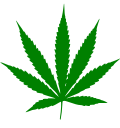Cannabis in Egypt
_-_front_-_TIMEA.jpg)
Cannabis in Egypt is illegal, but its use is a part of the common culture in the country for many people.[1] Penalties for the large-scale smuggling of cannabis in Egypt can include death sentences.[2]
History
Evidence has suggested that cannabis was present in Egypt since circa 3000 BP.[3] However, whether or not it used for psychoactive purposes during this time has not been documented.[3] It was stated in a book written in 1980 that cannabis cultivation has occurred in Egypt for "almost a thousand years."[3] During this time, cannabis was used for making rope and it was also cultivated for use as a drug.[3] Cannabis has been utilized in Egypt for hashish production for at least the last "eight or nine centuries".[3]
It has been stated that hashish was introduced to Egypt by "mystic Islamic travelers" from Syria sometime during the Ayyubid dynasty in the 12th century CE.[3][4] Hashish consumption by Egyptian Sufis has been documented as occurrent in the thirteenth century CE, and a unique type of cannabis referred to as Indian hemp was also documented during this time.[3] At this time, the Indian hemp was described as having been called hashishab, as only been seen (by the writer) in Egypt, and as having been grown in gardens.[3] Enforcement against cannabis dates back as early as around the 14th century, when cannabis users in Egypt could be punished by having their teeth pulled out.[5]
French period
During Napoléon Bonaparte's invasion of Egypt in 1798, alcohol was not available per Egypt being an Islamic country.[6] In lieu of alcohol, Bonaparte's troops resorted to trying hashish, which they found to their liking.[6] As a result of the conspicuous consumption of hashish by the troops, the smoking of hashish and consumption of drinks containing it was banned in October 1800, although the troops mostly ignored the order.[6] Subsequently, beverages containing hashish were banned in Egyptian cafes; cafes that sold them were shut down and "boarded up", and their proprietors were jailed.[6] During this time, hashish imported from other countries was destroyed by burning.[6] Upon the end of the occupation in 1801, French troops brought supplies of hashish with them back to France.[6]
Ottoman period
In 1877, the Ottoman government in Constantinople mandated that all hashish in Egypt be destroyed, and in 1879 importation of cannabis was banned by the Khedivate of Egypt.[7][8]
British period
In 1882 the British occupied Egypt, which remained nominally an autonomous Ottoman province but de facto British controlled. Soon after the Egyptian government issued an 1884 ban on cultivation, though officials were permitted to confiscate and export captured hashish rather than destroy it. Despite these measures, production and sale of cannabis continued, with authorities routinely shutting down premises where cannabis was consumed, into the 20th century.[8]
Economy
Cannabis is grown throughout the year in the Sinai Peninsula and in Upper Egypt.[9] The trade is largely focused in Sinai, and the area has been the main target of eradication efforts, with 7 million cannabis plants (along with 10.3 million opium plants) eradicated there in 1994.[10]
Cannabis culture
In 1800, French troops in Egypt noted that the Muslim locals both smoked the "seeds" of the hemp plant, as well as making a beverage from hemp.[11] A number of cannabis preparations combined with other psychoactive plants have been recorded in Egypt, including bosa (cannabis combined with bearded darnel) and a waterpipe smoking blend combined with henbane.[12] The gozah or josah is the traditional Egyptian water-pipe; a 1980 Egyptian study noted that smoking was the most popular method of cannabis consumption (89.4% of those surveyed), with the majority of smokers using the water-pipe.[13] A 1925 report noted that hashish that is "mixed with sugar and cooked with butter and flavoring, is made into the candy known in Egypt as manzul, maagun, and garawish."[14]
References
- ↑ Gibson, World News With Charles (May 5, 2010). "Egypt's Pot Problem? A Marijuana Shortage". ABC News. Retrieved July 29, 2015.
- ↑ Williams, David; Allen, Vanessa (June 3, 2013). "Egypt sentences UK pensioner to death for drug smuggling: Oxford graduate, 74, guilty over £3million cannabis haul". Daily Mail. Retrieved July 29, 2015.
- 1 2 3 4 5 6 7 8 Clarke, R.; Merlin, M. (2013). Cannabis: Evolution and Ethnobotany. EBL ebooks online. University of California Press. p. 234. ISBN 978-0-520-95457-1.
- ↑ "Timeline: the use of cannabis". BBC News. June 16, 2005. Retrieved July 29, 2015.
- ↑ James H. Mills; Patricia Barton (2007). Drugs and empires: essays in modern imperialism and intoxication, c.1500-c.1930. Palgrave Macmillan. p. 172. ISBN 978-0-230-51651-9.
- 1 2 3 4 5 6 Booth, M. (2015). Cannabis: A History. St. Martin's Press. pp. 76–77. ISBN 978-1-250-08219-0.
- ↑ India. Hemp Drugs Commission (1893–1894); Sir William Mackworth Young (1969). Marijuana: Report of the Indian Hemp Drugs Commission, 1893–1894. Thos. Jefferson Publishing Company. p. 270.
- 1 2 E.L. Abel (29 June 2013). Marihuana: The First Twelve Thousand Years. Springer Science & Business Media. pp. 133–. ISBN 978-1-4899-2189-5.
- ↑ William R. Brownfield (1 May 2011). International Narcotics Control Strategy Report: Volume I: Drug and Chemical Control. DIANE Publishing. pp. 263–. ISBN 978-1-4379-8272-5.
- ↑ DIANE Publishing Company (1 August 1995). International Narcotics Control Strategy Report, 1995. DIANE Publishing. pp. 417–. ISBN 978-0-7881-2057-2.
- ↑ Leslie L. Iversen (6 November 2007). The Science of Marijuana. Oxford University Press. pp. 29–. ISBN 978-0-19-988693-7.
- ↑ Christian Rätsch (1 March 2001). Marijuana Medicine: A World Tour of the Healing and Visionary Powers of Cannabis. Inner Traditions / Bear & Co. pp. 87–. ISBN 978-1-59477-659-5.
- ↑ Muṣṭafá Suwayf (1980). The Egyptian Study of Chronic Cannabis Consumption. National Centre for Social & Criminological Research. p. 111.
- ↑ Records of the Second Opium Conference, Geneva, November 17th, 1924 – February 19th, 1925 ... Imprimerie du "Journal de Genève". 1925. p. 133.
Further reading
- Rubin, V. (1975). "Traditional Patterns of Hashish Use in Egypt (by Khalifa, Ahmad M.)". Cannabis and Culture. World Anthropology. De Gruyter. pp. 195–205. ISBN 978-3-11-081206-0.

